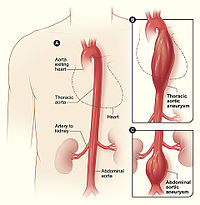
Photo from wikipedia
A myriad of heritable connective tissue disorders (CTDs) have been linked to an increased risk of developing aortic diseases and associated clinical complications such as aortic aneurysm, dissection, and/or rupture.… Click to show full abstract
A myriad of heritable connective tissue disorders (CTDs) have been linked to an increased risk of developing aortic diseases and associated clinical complications such as aortic aneurysm, dissection, and/or rupture. Marfan syndrome, one of the two CTDs investigated by Aranda‐Michel et al., is usually caused by mutations in the FBN1‐ gene producing abnormal fibrillin‐1 proteins and is the most common. Ehlers–Danlos syndromes (EDSs) however, are a heterogeneous group of CTDs consisting of 13 clinical subtypes, of which type IV or vascular EDS (vEDS) is caused by mutations in the COL3A1‐gene leading to abnormalities in type III collagen. The vEDS subtype represents around 5%–10% of the patients with EDSs. The specification of these several CTD subtypes based on a different genetic background defines precise disease entities with clinical characteristics that partially overlap. This may as well be an incentive to investigate differences or similarities in baseline characteristics and outcomes between patients with specific CTD subtypes and aortic disease, as Aranda‐Michel et al. have done meticulously. Given the combination of a low incidence and thus a paucity of high‐volume aortic centers to treat the vascular diseases associated with CTDs, analyses of outcomes of aortic disease concomitant to CTDs are scarce. To account for this complexity, the authors queried the database of the National Inpatient Sample (NIS) to identify a considerable number of patients with Marfan syndrome or EDS and aortic disease (e.g., aortic aneurysm or aortic dissection) that has been treated by either open surgical or thoracic endovascular aortic repair (TEVAR). The descriptive observational data and statistical comparisons of both CTD cohorts (e.g., Marfan and EDS) highlight a more advanced age and a higher percentage of female patients in patients with EDS as compared with Marfan. In‐hospital mortality rates were similar in both cohorts (Marfan: 4.56% vs. EDS: 2.78%, p = .26). A subgroup analysis including nonelective admissions only, found an increased but similar in‐hospital mortality between both cohorts (Marfan: 7.97% vs. EDS: 7.14%, p = .81). In both the entire cohorts and subgroup analysis, univariable regression identified aortic dissection as a significant independent predictor of in‐hospital mortality. We must emphasize that the interpretation and applicability of these findings may be limited by the large differences in cohort sizes. The Marfan cohort is more than 14 times larger as compared to the EDS cohort (Marfan: n = 2553 vs. EDS: n = 180), persisting in the subgroup analysis (Marfan: n = 976 vs. EDS: n = 70). Any differences or similarities that are presented between both cohorts might be related to these divergent cohort sizes. Nevertheless, increasing these numbers is challenging given the low incidence of CTDs, and the idea and effort to utilize the NIS for this purpose deserves to be complimented. In this regard, a propensity score matching analysis to account for differences in patients' baseline characteristics and other potential confounders between both cohorts might have provided a solution in an attempt to reduce this bias. Moreover, the use of ICD‐9 and ICD‐10 coding paradigms for patient selection may have introduced another bias. Although this is a straightforward procedure, there is no manual check and/or double‐ check to identify potential errors. The authors defined a clear
Journal Title: Journal of Cardiac Surgery
Year Published: 2022
Link to full text (if available)
Share on Social Media: Sign Up to like & get
recommendations!